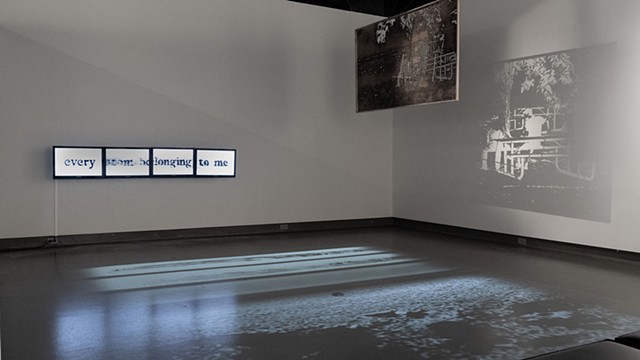RHIZOMORPH
Geographic coordinates of each location depicted in Rhizomorph are paired with a Walt Whitman passage stencilled in charcoal powder and blown away. The audio track weaves together the artists accounts of each site in 'Rhizomorph' with stories of queer spaces from the last three centuries that the artists have encountered in their "50 States Project".
A note about the stencil and shadow:
The Damron Guide was a pocket sized booklet that listed Gay and Lesbian spaces (mostly bars) everywhere in the United States, that could be easily carried around when traveling so that you could easily find ‘Family’ wherever you happened to be. In the 1974 edition, Hermann Hill Park in Wichita, Kansas is listed as a ‘Cruisy Area’, the first year the guide listed such areas “at the request of a number of readers”.
When you go to Herman Hill Park now, there is a police station that sits in the center of the parking lot. When we visited last June, the grass was spotty, the ground largely dry earth and dust. As far as we could tell, there’s no discreet corner or stand of trees, no public bathrooms, or anything else remaining that might hide a late night hook-up. No plaques, or dedications; no marker for this place that allowed our people to find each other and connect.
The afternoon we visited, two men were sitting a few feet apart from one another talking at a green enameled steel picnic table. We’re not sure if they were related, or friends, or strangers who just needed a place to sit. From behind though, just for a moment, the scene felt reminiscent of the late night cruising this park used to know so well: a nod of the head, a knowing glance, a little gesture . . . “you interested?” “You wanna. . . .?” Who knows, the likelihood is that they weren’t cruising (it was middle of the afternoon, after all . . . and right in front of a police station) but then again, who are we to assume anything, one way or the other?
We surreptitiously snapped a photo with one of our i-phones. Neither of their faces were particularly visible anyway. And we set out to make one of our wind drawings of the ‘couple’. We tried a few times (it often takes a few times) but this one wouldn’t come out. They refused to be captured, resisted depiction. In a body of work about the vanishing of ghosts, the absence and concurrent permanence of memory, of place, of our visceral and intuitive knowledge of our history, these two managed to slip away.
We weren’t immediately sure what to do with that stencil. It felt like it needed to be part of this work, part of this timeline, this architecture of our shared queer network, our family. . .And so here they are, immaterial, a trick of the light, a shadow.
